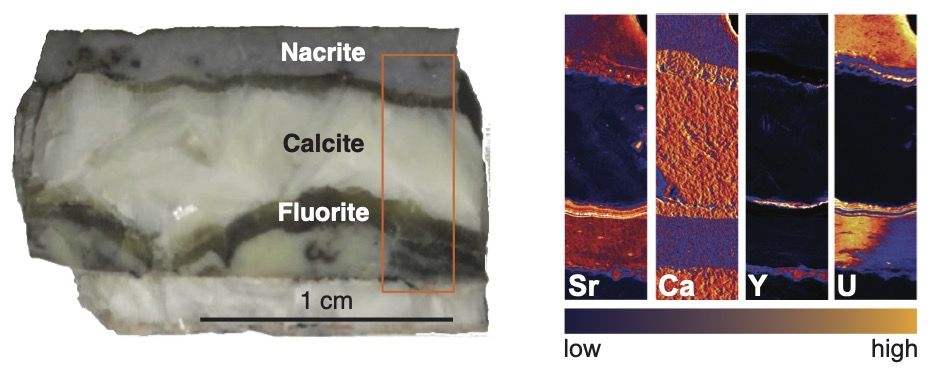Mineral and Ore Genesis
The green energy revolution has intensified the demand for mineral resources used in emerging technologies. In my research, I apply geochemical analyses to sedimentary rocks containing these “critical minerals” to investigate their formation and the conditions required to concentrate elements of interest. A key tool in these studies is synchrotron-based X-ray microspectroscopy. These investigations are conducted in collaboration with scientists at Stony Brook University and the National Synchrotron Light Source-II at Brookhaven National Laboratory.
 (Left) Rare Earth Element bearing hydrothermal rock from Round Top Laccolith, Texas. (Right) X-Ray Fluorescence (XRF) elemental maps. I use high resolution maps like these to help constrain ore-bearing phases in hydrothermal minerals
(Left) Rare Earth Element bearing hydrothermal rock from Round Top Laccolith, Texas. (Right) X-Ray Fluorescence (XRF) elemental maps. I use high resolution maps like these to help constrain ore-bearing phases in hydrothermal minerals
Tracking Ore Bearing Fluids
I have studied Rare Earth Element (REE) ores at the Round Top Laccolith in West Texas. This project revealed that REEs were concentrated in a carbonate mineral formed during a hydrothermal event that postdated the laccolith. It also involved some of the first U-Pb dating of fluorite and nacrite, hydrothermal minerals commonly associated with REE ore deposits. Find this paper in Geosphere.
Uranium Incorporation In Hydrothermal Minerals
I am interested in the environmental conditions and mineralogical processes that concentrate uranium in Earth’s crust. A key motivation for this work is identifying minerals suitable for U-Pb dating to refine age constraints on ore genesis. To this end, I am currently using X-ray Absorption Spectroscopy to investigate how uranium is incorporated into fluorite.
